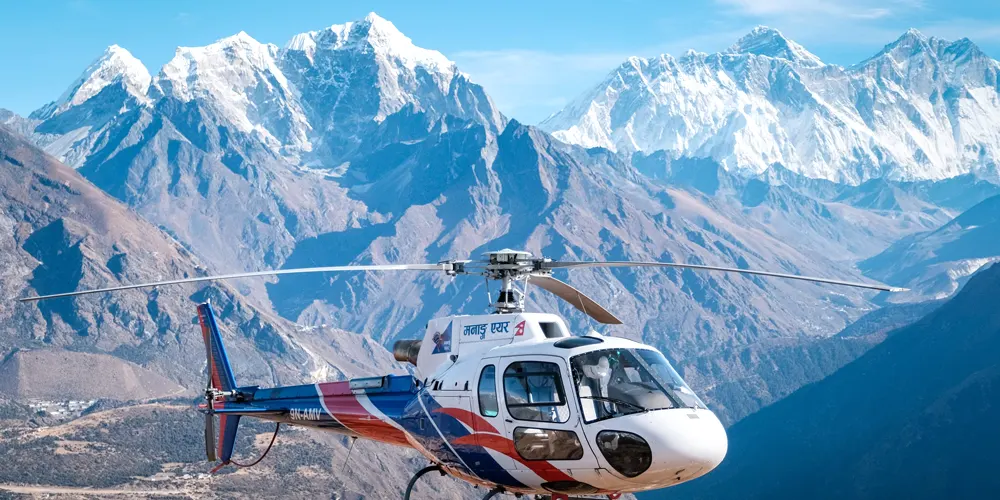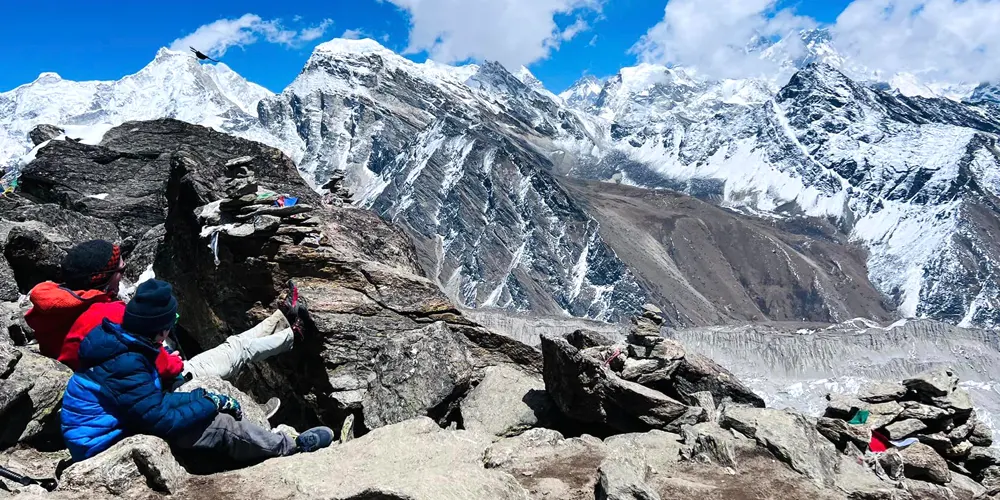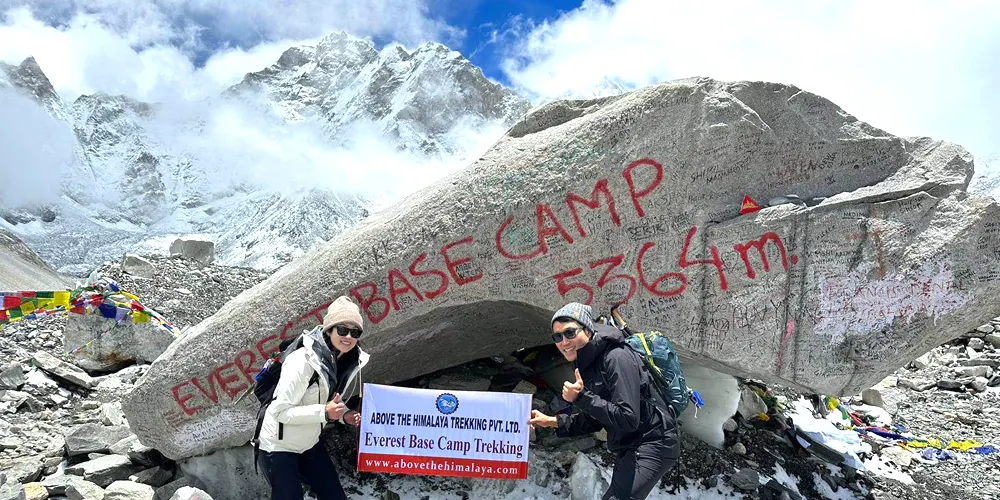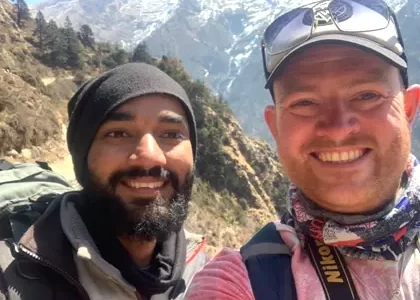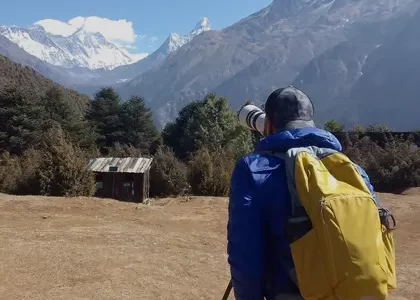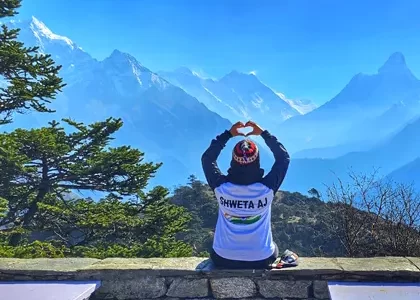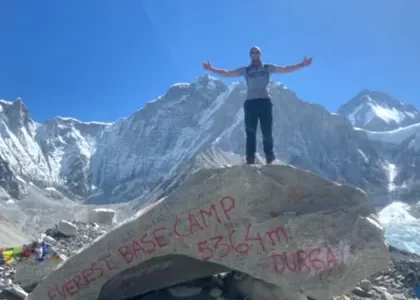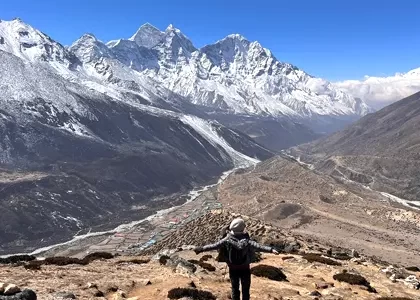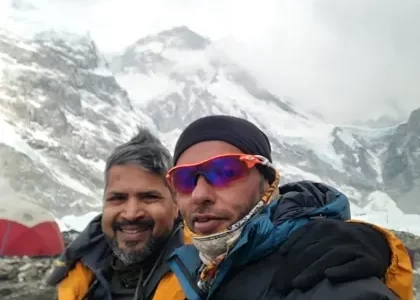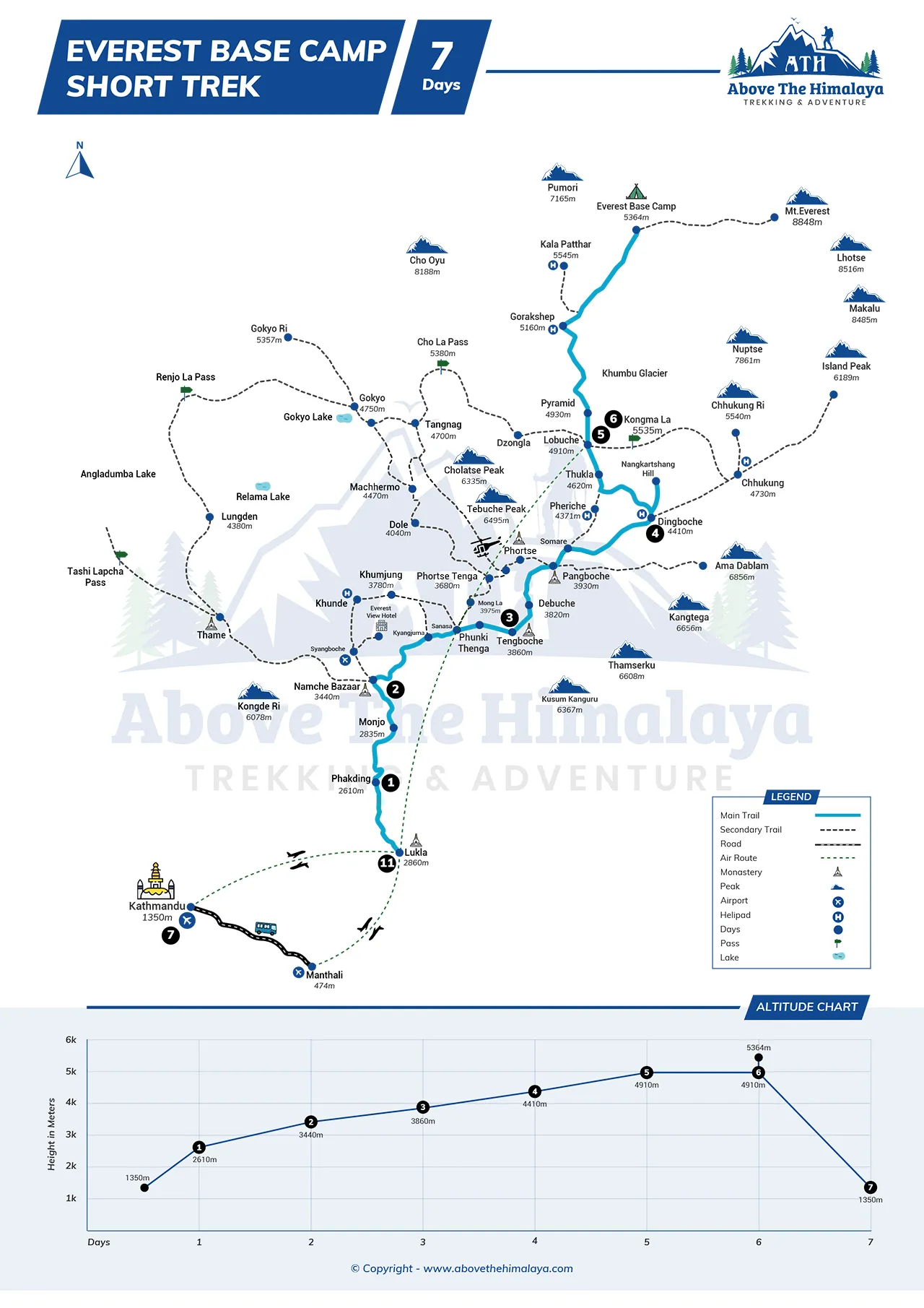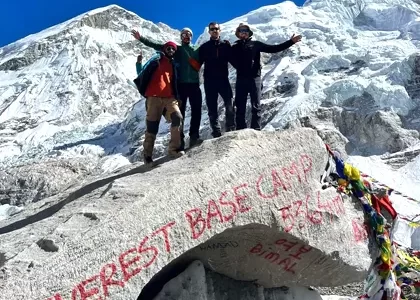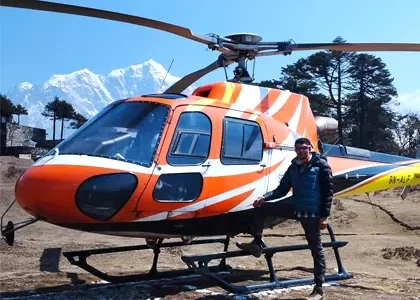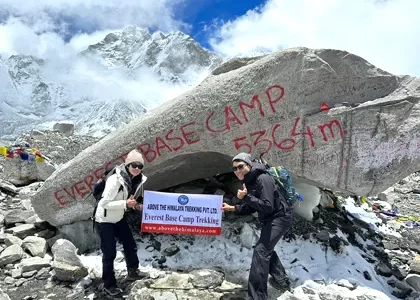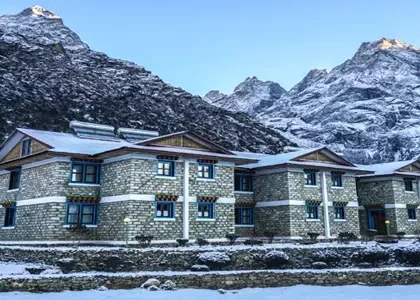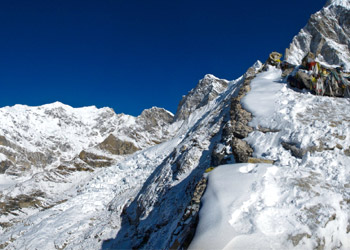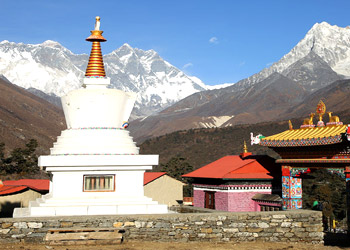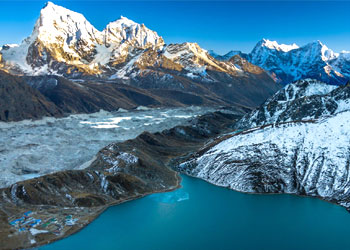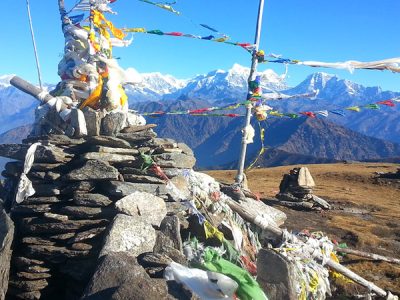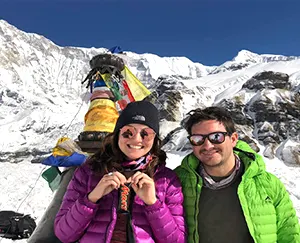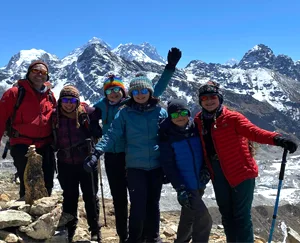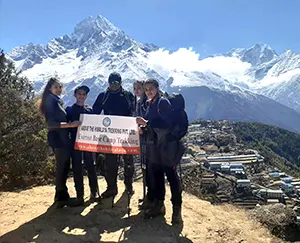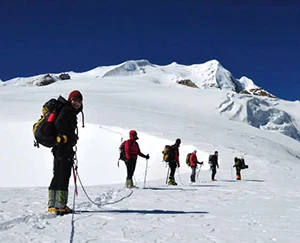Small Group Departure Dates for 2026 and 2027
Note: We can run an Everest base camp short trek for solo travelers, couples, friends, and family with children. Our private trips run daily. For small group travel, please check the dates below. If the dates below do not suit you, please email us or WhatsApp us at +9779851095800 to travel on your preferred dates.
Highlights of Everest Base Camp Short Trek
Everest Base Camp short trek is a fun journey that is not only rich in mountains and natural beauty. It is also a huge opportunity to explore the diverse Himalayan culture of Nepal.
- You will get insight into the culture of Sherpa people with warm Sherpa hospitality.
- Get familiar with the guides, making your trip memorable on your Everest base camp short trek.
- You will get the chance to enjoy your trek, which begins from Lukla.
- We passed through the valley of Dudh Koshi to Namche Bazar and then to the foot of Mt. Everest.
- You will encounter breathtaking scenes during your Everest base camp short trek.
- Enjoy the -lush green farmland and fast-flowing white rivers.
- Remote Buddhist monasteries, glacial pools, the splendid panorama of snow-capped mountains
- We are walking in the rocky mountains and the monumental Mt Everest before you.
- The best places to see Mount Everest up close would be a trek to Kala Patthar or Gokyo, as both lie in the Everest Region.
- You can walk approximately 7 -8 hours daily through the rough, rocky, gravel-strewn.
- The trek involves long paths going up and down on the rocky trail.
There are many other highlights in this short Everest Trek that you will find on the way to this fantastic journey. Be a part of this journey and be blessed in the Himalayas’ lap.
Overview of Everest Base Camp Short Trek
Everest Base Camp short trek of 7 days is the most iconic trip in Nepal’s Himalayas. It is a short trekking package in the Everest region for those with a limited time frame who cannot do the long 14-day EBC trek.
This adventure journey takes you to the foot of Mount Everest (8848 m), the highest mountain in the world. You can visit the Everest base camp on the trek for a memorial photograph.
Along the trek, you will have the opportunity to see other eight-thousand-meter mountains. Every year, more trekkers visit Everest Base Camp. Its beauty, peace, culture, and uniqueness draw them. You have the opportunity to be one of them.
The short Everest base camp trek for 7 days offers a fantastic adventure and brings you an unforgettable experience. Take in the breathtaking views of the Everest Himalayas in the Khumbu region. They will create memories that last a lifetime.
The ranges consist of five of the world’s highest mountains: Mt. Everest (8,848 m), Mt. Lhotse (8,501 m), Mt. Makalu (8,463 m), Mt. Cho Oyu (8,153 m), and Mt. Lhotse Shar (8,393 m). The area has natural wonders besides the beauty of the Himalayas. Also, UNESCO recognized this area as a World Heritage Site in 1979.
Everyone knows Mount Everest is the tallest mountain in the world. So, people often refer to it as the king of all mountains. The area is rich in pine forests and rhododendrons (Nepal’s national flower). You will have the best experience of the stunning views of Everest in the snowy world.
This 7-day Everest Base Camp Short trek also encompasses endangered species of birds and animals. On this trek, you will also experience Sherpa’s hospitality, culture, and traditions. The short Everest Base Camp trek is a must-try, once-in-a-lifetime experience. It will create the best memories at the world’s highest altitude.
Towering peaks like Changtse, Pumori, Nuptse, and Lhotse will greet you. Once you reach your destination, a vast expanse of snow and rock will surround you, creating a surreal moment in your life.
Overall, the view is not only about the height you achieve. Indeed, the short trek to Everest Base Camp offers a unique view and an exhilarating experience. But the view is stunning, and that starts with your journey. You’ll walk past settlements and find breathtaking landscapes and authentic traditions.
Traveling through the Sherpas’ settlement will reveal Buddhism. You will also see prayer flags, mani stones, and high-suspension bridges. You’ll find high-altitude plants and animals, too.
The Everest Base Camp short trek creates an ideal combination of nature and culture. The trek’s adventure and hardship pay off. It offers scenic views of diverse landscapes and ancient monasteries. The panoramic views of Everest and many other peaks will astound you.
Everest Base Camp Short trek route
Everest base camp short trek 7 day route is the most famous route in the Everest region. This journey is ideal for your getaway, and it will provide great refreshment for your work life. It also offers a spectacular view of all the Himalayan mountain ranges.
You also experience the biodiversity of Sagarmatha National Park’s flora and fauna. The trail winds through magnificent pine and rhododendron forests. It is a breathtaking beauty.
The route starts from Kathmandu flying to Lukla (in season time we need to drive to Ramechhap to take a flight). The trek starts in Lukla. It goes via Phakding, Namche, Dingoche, and Gorakshep. It finally arrives at Base Camp.
Within 7 days, you will have the best refreshments and lifetime memories in the lap of the Himalayas. Isn’t that amazing? Enjoy the best 7 days in a snowy world. It would be the perfect refreshment for your hectic work life.
The Everest Base Camp short trek takes 7 days and is quite challenging. When you reach the Base Camp, you will have climbed up to 5364 meters. From here, you will enjoy a close-up view of Mount Everest and other big mountains.
The short EBC trek has no vertical climbing. But you may see snow and ice on the trails, depending on the season. The snowy paths, glacier valleys, and amazing villages make your short Everest Base Camp trip memorable.
Everest base camp short trek 7 days Distance and its altitude in detail
| Trekking Route | Distance | Trekking Hours | Altitude |
| Lukla to Phakding | 8.2 kilometers/5.09 Miles | 3 to 4 hours | 2610 meters/8562 feet |
| Phakding to Namche Bazar | 12 kilometers/7.45 Miles | 6 to 7 hours | 3440 meters/11286 Feet |
What our guests tell about the Short Everest trekking
Itinerary of Everest Base Camp Short Trek
01
Day 01: Flight from Kathmandu to Lukla or Ramechhap to Lukla and Trek to Phakding
Today, we will start our Everest Base Camp Short Trek. We will take an early morning flight to Lukla from Kathmandu or Ramechhap Airport (March to early May, September to Early December, the flights are from Ramechhap).
You can experience Nepal’s initial rural landscape by taking a public bus, jeep, or van to Ramechhap.
Our 4- to 5-hour drive to Ramechhap will take us through the 6-lane highway of Bhaktapur. We will then go on the Araniko Highway, crossing the beautiful town of Dhulikhel. We will then travel to enjoy the tropical green hills and cultivated lands along the coast of the Sun Koshi and Tama Koshi rivers.
From Ramechhap Airport, we will take a domestic flight to Lukla. This 15-minute scenic flight will show us views of Nepal’s Everest and other Himalayan ranges, making our Everest Base Camp Short Trek worth it.
At Lukla airport, our local Sherpa guides and porters will welcome us. We will rest a while at Lukla to have our breakfast or lunch. Then, we will begin our trek to the village of Phakding, which will be an exciting part of our Short Everest trekking.
We will walk along the trail that follows the Dudh Koshi River. We will cross several small settlements, their livestock, and terraced fields. Then, we will reach Phakding, where we will rest for the night.
Note: In the Everest Base Camp Short Trek, the flight will operate from March to May. In other months, especially in low trek season and clear weather, direct flights of 35 to 40 minutes operate from Kathmandu to Lukla.
02
Day 02: Trek from Phakding to Namche Bazaar (3,440 m/11,283 ft). It takes 5-6 hours, with a 300-meter ascent and descent of 11.3 km.
After an early morning breakfast, we will start our short trek to Everest Base Camp. We will leave Phakding and ascend steadily, crossing dense forests of pine, fir, magnolias, and rhododendrons. We will then cross the villages of Bengkar and Monjo, entering the protected area of Sagarmatha National Park.
In today’s journey of the Everest base camp Short Trek, the authorities in Monjo may check our travel permits. Then, we must cross the famous Hillary suspension bridge over the Dudh Koshi River. We will then climb through the steep streets of Jorshale to reach Namche.
Along this route, we will see many porters and traders who supply food and other items to the entire Khumbu region. We will also have some majestic views of Kusum Kanguru (6369 m), Tamserku (6608 m), Everest (8848 m), and Nuptse (7879 m).
Namche Bazaar (3440 m) has a bakery, shops with modern gear, and lodges with amenities. We will rest at one of these lodges in Namche Bazaar to spend the second night of our Everest base camp short trek journey.
03
Day 03: Trek from Namche Bazzar to Tengboche (3,870 m/12,697 ft.). It's a 10.4 km walk, taking 4-5 hours. You'll descend 350 m, then ascend 750 m.
After breakfast, we will walk along a flat trail following the Dudh Koshi River. Then, we will go through small ups and downs before arriving at the small village of Kenjoma. Here, we will stop for lunch and some tea break.
After some rest, we will begin our steep downhill trek and reach Phungithanga. It’s the time to enjoy the magnificent views of Everest and Ama Dablam.
We will now have one last steep climb ahead that will lead us to the village of Tengboche. Here, we will be rewarded with a glimpse of Lhotse, Nuptse, Everest, and Ama Dablam.
In the evening, we will briefly tour its renowned Tengboche Monastery. Then, we will rest in one of the vibrant lodges of the village, spending the third night of our Everest Base Camp short trek itinerary.
04
Day 04: Trek from Tengboche to Dingboche (4,350 m/14,272 ft.). It takes 5 hours to walk 12 km. You will descend 70 m and ascend 580 m.
On the fourth day of our short trek to Everest base camp, we will leave Tengboche. We will head north, walk over a small suspension bridge, cross the Dudh Koshi River, and reach Orsho.
From here on, we will stay on the broadest paths of crossroads. We’ll enjoy another thrilling part of the Everest base camp short trek.
We will descend to a bridge that crosses the Imja Khola. Then, we will proceed with an uphill trek for about 45 minutes and finally arrive at Dingboche. It is a lively village with numerous comfortable lodges, where we will rest overnight.
We will have the opportunity to sleep in the lap of the Himalayan giants: Mt. Tawache, Ama Dablam, the north Pokalde (5741 m), Kongma-Tse (5820 m), and the high wall of Nuptse.
05
Day 05: Trek from Dingboche to Lobuche (4,940 m/16,207 ft.): walking distance 4-5 hours, 700 meters ascent, 9 km
On the fifth day of the Everest Base Camp short trek, we wake up early and enjoy breakfast. After breakfast, we will leave Dingboche. Then, we will walk the trail to the hamlet of Dughla.
From here, we will climb onto the terminal moraine of the Khumbu Glacier for about an hour. We will then turn left and arrive at the memorial area known as Chukpilhara.
We will pause to honor the memory of the Sherpas who died on the Everest expedition. Then, we will continue on the Everest base camp path that descends for a while. This path will take us to the western side of Lobuche village.
Outstanding views of the colossal Himalayas will greet us as we rest in Lobuche during the fifth day of our Everest Base Camp short trek.
06
Day 06: Trek from Lobuche to Everest base camp (5,364 m). Then, return to Gorakshep (5,170 m) and descend to Lobuche (4,940 m).
After a fulfilling breakfast, we will leave Lobuche. We will walk a path that climbs gently through meadows. After a while, we will pass a bend, from where the cone-shaped Pumori appears in front of our eyes.
On the lower slopes of Pumori, you can see a black ridge extending south as a peak. It is the famous Black Stone. From here, we will make a short descent to the sandy area of Gorakshep.
Get ready for an hour-and-a-half climb via a rocky path to Everest Base Camp. In clear weather, you can see the highest mountains: Changtse, Pumori, Nuptse, and Lhotse.
You will see Mount Everest and other Himalayan ranges from very close. After some time here taking photos and making Instagram reels, we will return to Gorakshep for a hot meal. Then, we’ll go down to Lobuche, as sleeping at a lower altitude is better.
07
Day 07: Early morning, take a helicopter from Lobuche to Lukla. Then, fly to Ramechhap or, if available, directly to Kathmandu. Flight hour: 15 minutes or 35 minutes and drive to Kathmandu.
Today, in the early morning, we will fly down to Lukla. We can hear the roaring of the helicopter engine as it takes us back.
In 15 to 20 minutes, we will be at Lukla. We will spend the night in the great Himalayas. This will happily end our Everest base camp short trek.
Today, we will say goodbye to our porters and take a flight back to Kathmandu or Ramechhap Airport. During the season, there is a flight to Ramechhap Airport.
In the latter option, we will again drive from Ramechhap to Kathmandu, enjoying the village’s rural surroundings. In about four hours, we will arrive in the capital.
If time permits, you can look around Kathmandu city and indulge in the lively city’s nightlife. Thank you for your Everest base camp short trek with Above the Himalaya Trekking Pvt. Ltd.
Trip Extension
Suppose you have more time in Nepal after this trip. In that case, we can help you to extend your trip by running different treks in Nepal, tours in Bhutan and Tibet, Jungle safari tours at Chitwan, Bardia, and other National parks, Nepal luxury hotel booking, Rafting, Ultra-light flights, or any other travel-related services. You can get more information here.
Everest base camp shrot trek Cost Details
What's Included?
- Airport / Hotel / Airport transfers by sharing Hiace vehicle for Lukla flight.
- Government license holder experienced trekking guide (trained in Wilderness First Aid& altitude sickness) with food, accommodation, salary, equipment, accidental insurance, clothing, and medicine.
- Local trekking porter ( 1 porter for two clients) with his food, accommodation, salary, equipment, accidental insurance, clothing, and medicine.
- Round Trip flight ticket for Kathmandu Lukla Kathmandu, in season time Ramechhap Lukla Ramechhap
- Gorakshep to Lukla Helicopter flight in a sharing.
- Tea house/Lodges Accommodation during the trekking on twin sharing
- During the trek, daily Meals are chosen from the Menu (breakfast, lunch, and dinner).
- Sagarmatha National Park fees.
- Trekker’s information management system (TIMS) card fee.
- A first-aid kit
- Above the Himalayan duffel bag. ( If you need to, please let us know before you book the trip and remind us in our pre-meeting at our office)
- Comprehensive pre-departure information and trip dossiers
- Above the Himalaya Gifts (T-shirt for Gents & Pashmina shawl for Ladies, Trekking certificates)
- All necessary papers, office Service charges, and all Government Taxes
What's Excluded?
- Any services in Kathmandu
- Nepal entry visa fee: you can get a Nepal visa upon arrival at the Airport.
- International Airfare/Airport Tax.
- Alcoholic, hot and cold drinks ( Tea & Coffee), hot water, hot and cold showers.
- Kathmandu Lukla Kathmandu Helicopter flight ( if you take instead of regular flights)
- Personal expenses include laundry, telephone calls, Wifi, sweets, Desserts, snacks, beverages, bar bills, camera and Phone battery charging.
- Travel Insurance (Essential – Should include emergency evacuation coverage while trekking up to 5500+ meters).
- Personal trekking gear, your items + better to take plastic crampons for winter treks and in bad weather.
- Any expense for early returning members due to sickness, injury, or other reasons. No refund will be entertained for any unused service.
- Extra expenses occurred due to unexpected circumstances like cancellation of internal flights, floods, strikes, etc.
- Tips for tour/ trekking staff.
Route Map & Altitude Chart
Addon option available in Everest Base Camp Short Trek
The Short Everest Base Camp Trek will have a few add-ons. They will provide more comfort for your dream journey. Please consult our travel experts to confirm the add-on options and upgrade your trip.
1. Upgrade Your Accommodation in Kathmandu:
You can upgrade your accommodation to 4-star or 5-star hotels in Kathmandu. Even though your package includes a decent accommodation option, you can easily convert it to a luxury stay.
You can stay at the Hyatt Regency Kathmandu, the Hilton Kathmandu, or any other luxury hotel and resort in Kathmandu.
2. Upgrade Helicopter from Kathmandu to Lukla:
If you want to continue the journey without a typical flight, you can upgrade your helicopter from Kathmandu to Lukla.
You can either upgrade to a shared helicopter or book a private helicopter. The latter is ideal for private tours or family moments.
3. Extra porter or guide during the Everest Base Camp Short Trek:
You can easily hire an extra guide or porter during the Everest base camp short trek. Experienced tour guides and porters are common in this region. However, the charges of the extra guide or porter are not included in your trip package.
4. Luxury accommodation during the trek:
Another popular add-on is luxury lodging on the short Everest Base Camp trek. You don’t have to adjust in tea houses or camping. You can easily choose a luxury hotel or resort on your way to the EBC short trip.
The rooms will be comfortable and feature high-end services in luxury accommodations. Depending on the quality of services and increasing altitude, the charge for a luxury stay is generally high. Please talk to our travel expert about room availability at luxury hotels in remote areas.
Best Seasons and different weather conditions
Our 7-day Everest base camp short trek is accessible in all seasons: winter, summer/Monsoon, autumn, and spring. But if you want to witness the Himalayan grandeur at its best, we recommend the seasons of spring (March to May) and autumn (September to November). December is cold, but the weather is clear, so we can do this trek.
The pre-monsoon days in spring and the post-monsoon days in autumn offer crystal-clear blue skies with pleasant temperatures and little chance of rain and snowfall. The spring temperature, on average, lies between 12°C-16°C during the day and drops to -8 °C at night. Similarly, the temperature of autumn days ranges between -1 to 15°C in the Everest region.
The forests and vegetation come to life with colorful crimson rhododendrons and other wildflowers. The rare snow leopard, musk deer, grey langur, and several other wildlife of Sagarmatha National Park will roam around our trails. However, the Everest Base Cap route will be pretty crowded, and the accommodation will be complete. But you will have plenty of opportunities to share other travelers’ experiences worldwide.
The winter days, December, January, and February, are freezing (-14 degrees Celsius), with the chances of heavy snowfall. But the winter days will be clear and sunny.
Likewise, the summer days of June, July, and August have high temperatures and high chances of rainfall, avalanches, and muddy and slippery trails. However, with better preparation and a well-planned itinerary, we can organize this trek even in winter and summer.
Trek Difficulty
Our short Everest Base Camp trek is challenging as it has no rest day in between. The trek is favorable for trekkers who have a very short vacation time and want to go to the foot of Mount Everest. The trek period involves 6 to 7 hours of hiking each day. Especially on the 6th day of the trek, the most crucial day, we must walk for almost 8 hours to reach the Everest Base Camp and return to Gorakshep. But our return journey will be lavish, which will be via a helicopter ride to Lukla.
Still, the initial trekking journey needs us to gain elevation each day, culminating at more than 5000 m altitude. Therefore, average physical fitness is required to tackle some steep slopes, as well as ascends and descends,
In addition, there are always some natural risks present in high-altitude treks. We cannot predict the weather conditions, injuries, and other traumas. Therefore, following our guide’s instructions, walking gradually with secure footing is necessary.
We advise you to practice running, walking for 1 hour daily with a backpack, swimming, and some cardio exercise. Please engage in these exercises at least a month before you join the Everest base camp short trek so you can complete your dream with ease and convenience.
It would help if you also prepared yourself mentally, as you will be hiking in a remote region of Nepal. The Everest base camp short trek is well exposed to Western tourism, and infrastructure has been well developed. However, in higher altitude zones, there are still only basic infrastructures, so there can be a lack of modern resources and luxury you are used to.
However, all your efforts, sacrifices, and preparation will not go unnoticed. The Himalayan behemoth will be standing, smiling at you, and greeting you all along the way.
Altitude sickness during the Everest base camp short trek
Although this trek lacks a complicated and exposed path, it still comes with the risk of altitude sickness. However, we cannot foretell that each member will experience altitude sickness because it is a condition that varies from person to person. Some may feel normal, while some may feel headache, fatigue, nausea, and vomiting at an altitude of 3500 m. We will recommend you to trek slowly at your pace.
From the second day, you will be at an altitude of more than 3440 m at Namche Bazaar. From here on, you will continuously gain elevation till you round up the trip to Kathmandu. Therefore, proper acclimatization, ascending gradually, and drinking plenty of fluid are necessary to prevent altitude sickness.
The best way to treat altitude sickness naturally is to descend to a lower elevation immediately. If you have any issues, you must inform our guide; he will take the necessary action for your safety.
Please be aware that, depending on your health, your group leader may decide to stop your journey. Please remember that some people are more prone to get sick at high altitudes than others.
You need to be aware of the signs and symptoms of AMS to recognize it. They are-
- Dizziness
- Upset stomach
- Tiredness
- Headache
- Nausea and vomiting
- Loss of appetite
- Sensing instability
- Difficulty sleeping
- Breathing problems
- elevated heart rate
You need to take prompt preventive action if you experience any of the symptoms, such as:
- Decent at a lower altitude (if possible)
- Don’t climb up the hill until 48 hours
- Rest until you feel better
- Have proper acclimatization
- Don’t work out or exercise
- Avoid smoking
- Avoid alcohol
- Having garlic soup or hot ginger tea can be helpful
- Take in a lot of water
Please note: You will be sent back to Kathmandu by helicopter for immediate deportation. This action will be taken if your health doesn’t improve further over the following 24 hours. Thus, get insurance covering the expense of reusing your helicopters.
Food, accommodation, and transportation during the Everest base camp short trek
Food and drink
We will cover your daily meals ( breakfast, Lunch, and dinner) expenses during our Everest base camp short trek. You will have full onboard meals (breakfast, lunch, and dinner) based on the menu provided by the lodge. You will have a hot, nourishing breakfast and dinner at the lodge, where you will shelter for the night. The lunch will be provided at the lodge or the house along the trail.
Numerous lodges along the trail to Everest Base Camp provide a wide range of food options. You can order omelets, Bread, Tibetan/Sherpa bread, potatoes, exquisite French toast, and a hot cup of black tea or coffee for breakfast. And why not try the famous Masala, honey lemon, or ginger tea?
For lunch and dinner, try Nepal’s authentic national dish—the empowering Dal Vat Tarkari (Lentil Soup, Rice, and Vegetables) with some pickles. The dish is guaranteed to provide the necessary fuel to walk for long hours. Also, try hot garlic soup, pizza, noodles, and the world-famous Momos.
It would help if you drank plenty of water to prevent altitude sickness. But it must be safe drinking water, so ask the lodge owners for boiled water. All the lodges will fill your bottle with boiled water on request. However, you may not have that luxury along the trail, so carrying water purification tablets or water purifiers is a convenient and safe way to access safe drinking water immediately.
We don’t recommend buying mineral water bottles in the shops or lodges. We promote safe, Eco-friendly tourism, and plastic bottles harm the environment. Plus, it will be pretty expensive, especially at higher altitude areas.
Accommodation on Everest base camp short trek
Along with food expenses, we will also take your accommodation needs during the trekking period to Everest Base Camp short trek. All along the trail to Everest Base Camp, there are many lodges and guest houses in various Sherpa villages. At lower altitudes such as Namche, Tengboche, and Dingboche, the lodges will be well-equipped and comfortable. Some also provide free wifi service along with hot showers. Some lodges also come with a single room with an attached bathroom. You can upgrade the trek to the luxury version by paying the additional cost, like staying at a luxury lodge.
But as our altitude increases, the accommodations will also be more straightforward. They are the tea house accommodations run by friendly Sherpa families who make you feel at home. Rooms, in general, are small in size, with beds, pillows, mattresses, and some furniture.
The room will be cold, so bring your sleeping bag for warmth and comfort. You may have to share bathrooms, toilets, and dining areas with other trekkers. However, the common dining area is pleasant and warm, with the stove always burning.
Rooms may have plugs for charging electrical devices, for which you may have to pay an extra cost. A hot shower with a bucket of hot water may be available, for which you will also be charged an additional fee.
Transportation
As our guest, you deserve the best comfort and convenience. Therefore, we will also take care of all your air and ground transportation during the entire Everest Base Camp short trek. From Kathmandu or Ramechhap, we will fly to Lukla on a small domestic flight.
If you wish to have an initial adventure through Nepal’s rural setting, we can also drive you to Ramechhap in a private vehicle (jeep). From Ramechhap, we will arrange a brief flight to Lukla. In case of flight cancellation, we will book the next available flight as soon as possible.
Regarding your departure from Everest Base Camp, you will travel in grand style via a comfortable helicopter ride to Lukla from Gorakshep. The supreme Himalayas will be literally below your feet. From Lukla, we will again fly you to Kathmandu in the same way we began our journey.
If you want to take a short excursion of the Kathmandu Valley, we can also organize an exclusive private tour with a tour guide and personal driver at an additional fee.
Essential equipment for the Everest base camp short trekking
Preparing a backpack for a multi-day trek of Everest Base Camp is critical as we will walk through a wild, remote environment with potentially adverse weather conditions. Therefore, we must pack a lot of clothing and gear, but remember, it should be as light as possible.
If you forget any clothing and gear in Kathmandu, you can buy or rent them in Lukla or Namche Bazaar. Here is the list of materials and equipment you need to pack:
Backpack: The size depends on your clothing and material, but 35 to 45 liters is appropriate.
- Hiking Boots: Waterproof mountain and winter boots
- Underwear (waterproof)
- Sleeping Bag: Warm sleeping bags that can warm you even in minus temperatures of Everest region
- Warm and waterproof down jacket
- Warmer trekking pants
- Waterproof thermal trouser
- Thermal T-shirts and full shirts
- Summer and winter socks
- Thin and winter gloves
- Sunglasses
- Sunscreen
- Hat and neck Warmers for covering your head
- Flipflops or sandals for the evening
- Microfiber Towel
- Mobile Phone, Charger, Power bank, Camera (based on your need)
- Hiking Poles
- GPS, Compass
- Toilet Paper
- Water purifier/Water Purification Tablets
Average group size
We can organize trips for solo travelers, couples, friends, and family with children. Our private trips run every day.
As a reputed travel and trek company in Kathmandu, we believe our guests should have an intense and personalized experience and a relaxed atmosphere during the Everest base camp short trek. Therefore, we organized our tour in groups of 6 to 8 people.
We believe the more significant the group, the more strenuous the trip will be. Plus, we want our group members to know each other and feel comfortable with each other. Therefore, on day 1, as you arrive in Kathmandu, we will organize a small briefing program where we will introduce each member.
We also provide one experienced, licensed local guide and one porter for two guests in each of our Everest base camp short trek journeys. In small groups of 6 to 8, our guide can provide equal attention to each member, answer their queries, and provide assistance when needed.
If you don’t want to travel with strangers, you can also come up with your friends and family members to experience the thrill in a more personalized way. Plus, you can also enjoy the bonus of a group discount!
However, in peak trekking season, we often must incorporate more people into one group. We provide an assistant guide for more extensive group expeditions in such cases.
Rest assured, no matter the group size, we guarantee 100 % service to each guest.
Travel Insurance
It’s always necessary for us to have evacuation procedures. So, choose guides with years of expertise in bringing people to the Everest base camp trail.
As it is one of the challenging trips, there might be the risk of getting injured on the short trek to Everest base camp. Injuries like a twisted ankle, a high altitude issue, and leg pain will likely happen, so you need to adjust to the altitude better.
We want to ensure our guests are comfortable and safe on the journey. They must be taken to a lower altitude if they become ill or cannot continue the trip. Or, they will be sent back to Kathmandu if their situation worsens. Moreover, we take every precaution and go forward with a very high success rate.
Thus, before beginning the walk, we recommend you get trustworthy travel insurance. An insurance coverage called travel insurance can support you if you are evacuated.
Your travel insurance will cover the expenses associated with the accident. It will also arrange for a helicopter rescue if needed.
Why Private and Tailor-made Holidays?
A private and tailor-made trekking holiday allows you to personalize your holiday, and we customize your holiday plan to your needs. Whether you are a single person, couple, or family, we can run the Everest base camp short trek for you per your requirements.
Everest base camp short trek private Tailor-made trips also offer the following:
- Flexible dates
- Only the destinations you want to see
- Your schedule and place
- Authentic experiences in ‘unknown’ places
- Expert local guides with insider knowledge
- Trip as per your budget and group size
- Group discount for large groups
- Hassle-free transfers and private drivers
- Peace of mind
You can travel with your friends and family as we provide extra care and help for older people and children. You feel safe with our personalized service, private travel guides, and tour coordinators. They cater to your individual needs and enjoy high-quality, seamless experiences.
You have complete control over your trip itinerary for your Everest base camp short trek. When and where you want to go, what you want to do, and where you want to stay. You can choose the type of transportation and cancel or add activities to your trip.
Everest base camp short trek vs. regular EBC trek
As the Everest Base Camp trek became increasingly popular, new routes to the Base Camp emerged. However, sticking to the classic route, the trail usually involves passing from Lukla, Phakding, Namche Bazaar with one rest day, Tengboche, Dingboche (a second rest day with an option to climb Nangkartshang peak), Lobuche, and Gorakshep.
You usually ascend the Kala Patthar peak from Gorakshep and then go to Everest Base Camp. Then descent to Pheriche or Pangboche, Namche and Lukla.
Our 7-day short trek to Everest Base Camp will also take you through the same stages in the initial phase. But as the highlight itinerary of our trek arrives, we will only ascend to the Everest Base Camp, skipping the climb to the Kala Patthar. From Gorakshep, we will return on an adrenaline-rushing helicopter flight.
Generally, any traveler with a basic level of physical fitness can complete the Everest base camp short trek without technical knowledge or experience.
The classic Everest Base Camp trek is more complex than the short trek. Days on the trail are longer and more exhausting, with fewer amenities. You need basic knowledge of climbing, trekking, and using some equipment. However, the regular Everest Base Camp trek is more rewarding, wilder, exciting, and fun.
The main aim of making this trek shorter is to incorporate each person so everyone can fulfill their dream of seeing Everest with their own eyes. Our itinerary most days involves 4 to 6 hours of hiking, so every traveler, regardless of their age and fitness level, can easily carry out the trek. This trek is, therefore, a perfect holiday for family and friends who wish to spend the most fabulous holiday season in the bosom of Mount Everest.
View From Everest Base Camp
After a thrilling adventure to the Everest Base Camp, you will finally be in the presence of the mighty Himalayas. While you are at the foothills of the Himalayas, Mount Everest is not the only view you will get to experience.
You are greeted with towering peaks such as Changtse, Pumori, Nuptse, and Lhotse. As you are in the destination, you will be surrounded by a vast snow and rock expanse, a surreal moment in your life.
Overall, the view is not only about the height you accomplish. Indeed, the short trek to Everest Base Camp provides a one-of-a-kind view and a thrilling experience. However, the view starts with your journey as you walk past several settlements and come across authentic traditions and breathtaking landscapes.
On your journey, you will pass through the settlement of the Sherpas and get a glimpse of Buddhism. You will also see prayer flags, Mani stones, high-suspension bridges, and high-altitude flora and fauna throughout the trails.
The short Everest Base Camp trek perfectly blends nature and culture. The adventure and hardship during the trek pay off with scenic vistas of diverse landscapes, ancient monasteries, and more.
Everest base camp short trek for 2025/2026
Our Everest base camp short trek 2025 and 2026 booking is open, and you can book your adventure journey for any date. Most of our groups are small and tailor-made. You can make your trek on a private trip or join our small group. We operate from 2 people to 10 people groups.
If you are with your loved one or friends, you can do a private trip. Also, we can make the trek itinerary 12 days from Kathmandu to Kathmandu.
Most Asked Questions by Travellers
For those who are not feeling it for a long hike or have a limited time and yet want to enjoy the magnificent presence of the Himalayas, the short Everest Base Camp trek is for you. You can accomplish this journey in between 7 and 10 days, depending on whether you want a heli return.
This journey starts and ends at Lukla, which is the gateway to the Everest region. After Lukla, you will pass through the major destinations such as Phakding, Namche Bazaar, Tengboche, Dingboche, Lobuche, and finally to the Everest Base Camp.
Altogether, this trip will help you immerse yourself in the Sherpas’ authentic culture and experience their day-to-day life. Alongside it, you will also get to acknowledge the Buddhist and Tibetan traditions and practices.
You will also walk through the Sagarmatha National Park, a World Heritage Site, and get up close to Mount Everest, the world’s highest peak.
This trek is difficult for beginners as it lasts 7 days and does not include rest. If you are doing it for the first time, you can do our other longer trek with acclimatization days.
This trek requires you to walk 6 to 7 hours daily with our rest day. The altitude level will also cause difficulty during the Everest base camp short trek. As a beginner, even a few hikes around nearby places and cardio training will significantly help. You should be fit enough to walk along and take your belongings.
So, if you do not want to walk 6 to 7 hours a day with advancing altitude, you will also have many other route options. You can create your itinerary using the routes you want.
The shortest trek we can do for Everest base camp is 7 days. However, you can extend the number of days of your trip for acclimatization if you have time.
In the meantime, you should understand that multiple factors affect the duration of your trekking trip. The classic route to the Everest Base Camp short trek can be accomplished in 7 days, and it will take you through all the significant points. It starts and ends at Lukla, and we will take a helicopter down from Lobuche.
You can also take alternate routes for the trek, reducing the number of days. Likewise, you can opt not to ascend to higher altitudes or even take a helicopter ride. From exploring the Everest Base Camp in just two days to extending the trip to 14 days, you can personalize your entire trip.
Apart from the trails, the journey can stretch according to your fitness level. The path to Everest Base Camp is rocky with steep ascents, so your health must be at the top level to withstand altitude sickness.
Above all, you must keep a buffer time in unforeseen circumstances such as unpredictable weather and postponed flights.
Yes, you can do the Everest base camp trek in 7 days. The Everest base camp short trek in 7 days starts from Kathmandu and ends at Kathmandu. You will go to base camp, and from Lobuche, you can take a helicopter flight to Lukla and take a regional flight to Kathmandu. However, you will not have enough rest days and time to climb Kala Patthar in a 7 day Everest base camp trek.
Reviews on Everest Base Camp Short Trek
![]()
![]()
![]()
![]()
![]()
Based on 300+ Reviews

Mark Hernandez
Mexico
Everest base camp short trek - a life time experience
Everest base camp short trekking was a lifetime experience for us. We had an 8-person group for this trek, and all were successful in the base camp and visiting Kala Patthar. Our whole group never had a problem on the trek and enjoyed the beauty and surroundings en route.
The mountain views of Everest and other peaks were stunning. We felt safe and lucky to choose Above the Himalayas for this trekking. They did a fantastic guide for all the arrangements. We recommend this company.
Mark Hernandez

Mariska Smit
Spain
Solo female trekker - Safe Trekking
I did a solo Everest base camp trek. I had a fantastic time with my guide, Bishnu, who always cared for my lodging and meals. He was experienced, had done this trek many times, and was always ready to help.
The guest house he chose was lovely, and the best thing he provided was a private room for me. I organized this trip with Puru, who read all my emails and suggested what to take and how to travel before the trek.
They organized everything for me from Arrival to Departure. They met me at the airport with flowers, which were so welcoming and memorable. This is very safe and good company for single female travelers.
Mariska Smit

Mohan Gopal Krishnan
India
Incredibly Awesome
We went for a short Everest base camp trek in December, right at the end of the season. We had booked our trip through Above The Himalayas.
Since this was our first serious trek, we were pretty apprehensive. We could not have had a better experience as everything was almost perfect. Mr. Puru is accommodating with the flight and necessary bookings. He ensured we were comfortable in our hotels and even offered to pick the tabs for all meals that extra day.
Although we were a small group of 8 people, he still sent two guides with us -Ramesh and Gokarna (Goki, as he was called ). Couldn’t have asked for better ones. By the end of two weeks, we had become good friends with them.
Ramesh was a very responsible and sensible person who was very well aware of his duties as a guide—he never had a dull moment with Goki around, he being the perennial entertainer. The stay, food, hospitality, and personal touch exceeded our expectations.
We never felt isolated and helpless in that inhospitable terrain. We would come back to Nepal for a trek again and book through the same company. Without hesitation, he asks for Ramesh and Gokarna to be his guides. The Everest base camp trek has been the most fantastic experience of our lives.
Mohan Gopal Krishnan

Amy Bowzaylo
London, United Kingdom.
Best trek, frienly guide, great company
We had a fantastic journey to the Everest base camp short trek. Thank you, Above The Himalaya and the entire team. The owner, Puru, helped respond to our emails and queries about the trek and prepared us for it.
Our trekking guide was amiable and helpful in every way. We had a very kind and robust porter. Both of them were very patient, kind, helpful, and knowledgeable. They were always there for us if we needed any services.
We will return to Nepal for the Annapurna base camp trek and contact these guys. It is highly recommended!
Amy Bowzaylo

Klemens Riha
Australia
Best View from Kala Patthar
We had finished our short Everest base camp trek organized by Above The Himalayas. I must say everything was perfect from the start to the end. Our guide always ensured our safety and enjoyment of our trek.
The views from Kala Patthar were perfect. Instead of going early in the morning, our guide took us there for the sunset. It was not that cold in the evening compared to early morning.
The itinerary was well-planned and had enough acclimatization. Thank you, Above The Himalaya Trekking, for an incredible trekking adventure.
Klemens Riha

Low Lee Hoon
Singapore
Excellent trek with an excellent tour company
My husband and I, both retired, had trekked Everest base camp short trek. We went there through the Above The Himalayan tour agency. Puru is very experienced and well-connected. They were able to manage timely alternative flight arrangements.
It’s prerogative to have a quick response time to work unexpected turns of events. Puru has it. He also checked on us throughout our stay, including pre and post-trek tours. He also gave us advisories and helped with our alternative lodgings.
It is an efficient 5-star company with excellent service and a kind heart. We recommend this company to anyone. We will look up Puru again when we are in Kathmandu. Thanks, Puru and team.
Low Lee Hoon

Alexandder Harth
London, United Kingdom.
Everest base camp short trek with helicopter return
I did the short trek to Everest Base Camp and took a helicopter to Lukla from Gorakshep. Everything worked out well, and I enjoyed the trip.
The best thing was that we had an excellent guide who was very knowledgeable about the local culture on the trek. Make sure you choose a good company for this trip. Above the Himalayas is the one choice in Nepal.
Alexander Harth

David Berslin
Manchester, United Kingdom.
Everest base camp small group trek
A mixed group of 8 people did a 7-day trek to Everest base camp with Above The Himalaya Trekking. From the early planning to the end of the trip, it was an outstanding experience.
Mr. Puru, the owner of Above The Himalaya, was beneficial. We got all the information for the trek and got the help that we needed. I would recommend using Above the Himalayas for your adventures in Nepal.
David Bersli

Jessica Hernandez
Miami, USA
Amazing Experience !
My husband completed the short trek to Everest Base Camp, which was amazing! Above the Himalayas is a great company, and I recommend booking a trip with them.
Puru’s owner goes above and beyond and is professional and knowledgeable. You will not regret your decision with this company’s excellent communication.
Jessica Hernandez

Christopher Lim Siy
Philipines
Extraordinary Service and Experience
I just completed my short trek to Everest Base Camp, and it was one of the best experiences I’ve ever had. I booked the trip through Above the Himalayas, and the service was impeccable.
The owner, Puru, indeed went above and beyond to assist you every step of the way and would constantly contact you as you go along with your journey to the top of the world.
The guide they provided me (Shiva) was very knowledgeable and accommodating. They will adjust to your changes to ensure a comfortable trek toward your destination.
Christopher Lim Siy

Jocylyn Lim
Singapore
An amazing & Enjoyable Trip to Everest base camp
A fantastic trip to the short Everest base camp with our family with the help of Above The Himalaya Trekking. They did a great job to arrange this trip.
All the thanks go to our guide Basu and porters, Pemba and Temba, who took good care of us and supported us from our trekking days to Everest base camp till the end of the journey.
Thank you, Puru, and the whole team who helped us make this trip memorable.
Jocelyn Lim & friends

Amanda Hall
Washington DC, New York.
Best Trekking Organizer
The short trek to Everest Base Camp was very well organized. Our special thanks go to our guides, Sitaram and Porter Bhala. They were very polite, patient, and supportive of us from the start date to the finish date.
Amanda Hall

Maria Sheldon
USA
Short Everest base camp trek 7 days best adventure ever
Thank you, Puru, for arranging the Everest base camp short trek for 7 days for us. We had a very short time, and Puru put the best trekking for us. We took the Helicopter flight back from Kala Pathar to Lukla. It was a great flight and saved us time.
It was a great decision rather than coming down in the same way, and I had some knee problems. The guide, Basu, is very polite and willing to help in every aspect. We had a robust porter also.
Thank you again, Above the Himalaya and team
Maria Sheldon
USA

Sean Coughlan
Dublin, Ireland
Brilliant short trek to Everest base camp - Highly Recommended
We returned after our Everest base camp short trek from Above the Himalayas Trekking. The trek itself was amazing. It offers a stunning part of the world with jaw-dropping views.
We observed “big mountain” feels throughout. And the Nepali people were warm and welcoming.
Above the Himalaya Trekking’s organization of the trek was exemplary. Everything was exactly as promised, and the whole thing worked out. It leaves us to focus on making the most of our time in the Himalayas.
Puru, the owner of the company, was helpful and responsive. He was very welcoming both before we arrived in Nepal and while there. Highly Recommended
Sean Coughlan

Brian Newton
Sydney Australia
Very safe and reliable trekking company
I recently took a short trek to Everest Base Camp and had a great time. I booked almost a year in advance and got good advice from Puru on the best options.
He is always easy to contact. The short trek to Everest base camp was well organized, with a good guide in Suresh and Porter in Palden.
It was harder than I expected, with freezing nights, but being in the mountains was spectacular. Puru and the team at Above the Himalayas can undoubtedly be relied upon to ensure you have a safe and comfortable trek.
Brian Newton
Sydney, Australia

Alan Rosen
California USA
Trekking with Above The Himalaya - Best Experience
Mr. Puru and his team of guides were excellent! One of our group’s goals was to use a Nepalese company, and Above the Himalayas did not disappoint us. We were a group of 12 friends, with some planning on going to Everest Base Camp for a short trek. A few members were doing the more extended Three Pass Trek.
Due to unforeseen circumstances (one party member had acute mountain sickness and pulmonary edema, and we underestimated the rigors of the Three Pass Trek), our plans changed several times mid-trek.
Mr. Puru and his team handled all these events flawlessly, from arranging for a helicopter to evacuate our ill friend to rearranging the trekking routes (which involved splitting the party and the guides/porters and changing the lodging) so all could have a memorable experience.
And have a memorable experience from the scenery to the culture to the people! Above the Himalayas made it happen!
Thank you for the best Everest base camp short trekking to Above the Himalayas
Alan Rosen
California, USA
Book with Confidence
- Flexible bookings and easy trip date changes
- Personalized service and customized group sizes
- Safe travels with owner-operated services and highly experienced guides
- Best price guarantee for the most value for your money
- Secure & easy online booking
Your Trek Leader
 Enjoy Himalayan scenery with the help of Nepal’s best guides with Government license holders and got training in first-aid, our Trip Leaders, know where you’ll find the best photos, most fascinating wildlife, and the best stream crossings.
Enjoy Himalayan scenery with the help of Nepal’s best guides with Government license holders and got training in first-aid, our Trip Leaders, know where you’ll find the best photos, most fascinating wildlife, and the best stream crossings.
 Have Questions?
Have Questions?Talk to Expert
Meet Mr. Purushotam Timalsena (Puru), Nepal's best trek and tour organizer, who has been working in the Himalayas for more than 24 years.
WhatsApp/Viber +977 98510 95 800
